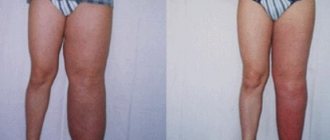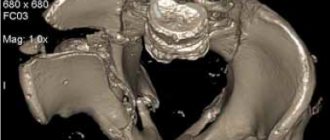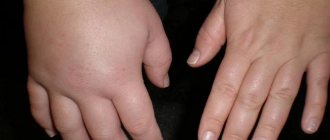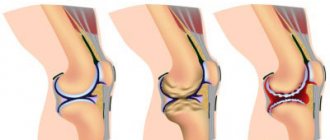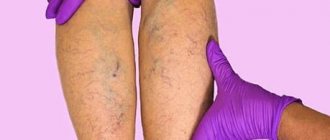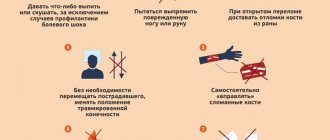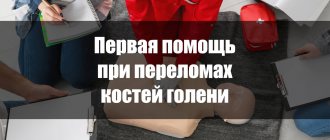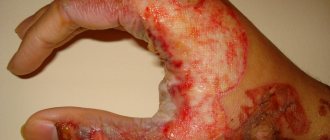A fracture is a violation of the integrity of a bone under the influence of an external force that exceeds the strength of the bone. With an incomplete fracture, a partial violation of the integrity of the bone occurs with the formation of a fracture, crack or holey effect of the bone tissue. When treating fractures, it is important not only to restore the integrity of the bone and its anatomical shape, but also to improve the function of the damaged parts of the body.
1
Treatment of fractures
2 Treatment of fractures
3 Treatment of fractures
Bone fractures can lead to complications such as:
- disruption of vital organs (heart, lungs and brain);
- the occurrence of paralysis as a result of injury to nerve cells by bone fragments;
- infection and the appearance of purulent inflammation in the area of the open fracture.
To avoid various complications, medical care for fractures and other injuries should be provided as quickly as possible. It is very important to transport the victim to a hospital or emergency room in a timely manner!
Stages of recovery after a fracture
In order not to aggravate the situation and cause even more harm to the body, it is necessary to treat a fracture at home in accordance with a clear sequential scheme. It provides the following main recovery stages:
- The first stage begins immediately after the plaster is removed. At this time, the damaged area needs to be rubbed and massaged. Start exercises and massage almost immediately, but they should be light and not overload the still weak muscles. To stimulate recovery processes, local preparations in the form of a gel or cream can be applied to the area, but only as prescribed by a doctor.
- The second stage begins when the muscles, ligaments and other structures become a little stronger. To increase tone and motor activity, begin exercise therapy, physiotherapy, and perform more complex and intense exercises.
- The third stage is the final one. During this period, you can already increase your activity and go for long walks. The doctor can give a referral for treatment at a sanatorium or health center.
Treatment of fractures: what fractures are treated at the Ladisten Clinic
Treatment of fractures is a long, complex and labor-intensive process. Breaking is not building. Getting injured is easy, everyone is at risk. Going to the gym, rollerblading and cycling, slippery floors in restaurants, winter ice, osteoporosis[1] - the dangerous factors can be listed endlessly. Repairing a broken bone is difficult, but possible. The Ladisten Clinic treats open and closed fractures of varying complexity and location. A unique technique allows you to speed up the fusion process and quickly return a person to normal life.
Assistive devices and additional activities
Simple additional remedies that can be used at home will help increase the patient’s comfort during recovery after a broken leg:
- Orthopedic insoles. They help not to overload the injured limb, relieve stress from bones and joints.
- Belt. Special straps are attached to the bed, so the patient receives additional support when sitting down or standing up. Patients with a hip fracture especially need such a device.
- Crutches or cane. Depending on the severity of the injury, in the early recovery period the patient may require assistance while walking. Auxiliary supports will relieve excessive stress from the limbs and give the patient confidence during movements.
Rehabilitation measures provide for a uniform increase in the load on the body. Initially, the doctor prescribes simple breathing exercises to the patient, which help saturate the body with oxygen and develop the respiratory system. Afterwards, exercise is added, which is aimed at developing general body mobility. After about a month, physical exercises are expanded and divided into two groups:
- general – aimed at improving the health of the whole body;
- special ones - restore the damaged area.
Properly selected gymnastics and a course of physical therapy restore blood circulation, strengthen muscles, resume motor activity and prevent complications.
Prevention
It is possible to prevent a displaced fracture by following simple recommendations:
- be careful, do not neglect safety rules at home and on the street;
- wear comfortable shoes;
- exercise to strengthen muscles and develop endurance;
- Healthy food;
- If you are interested in extreme sports, use preventive bandages to prevent injury.
If a fracture cannot be avoided, you must immediately consult a doctor for diagnosis and proper treatment.
Recovery in a supine position
For fractures of the extremities, recovery must begin when the patient is in a supine position and cannot stand. Only an early start of rehabilitation allows you to achieve maximum results. Otherwise, the muscles become inactive and weaken, causing the bones to heal incorrectly.
The complex of therapeutic exercises for a bedridden patient includes:
- shoulder lifts;
- lifting on the forearms;
- hand rotations;
- flexion, extension, pulling the healthy leg to the chest;
- contraction and relaxation of the muscles of the legs and arms;
- raising, abducting, bringing the injured limb to the body.
At the initial stage, these exercises should be performed under the supervision of a specialist and with his help. Over time, the patient will be able to perform gymnastics independently.
Clinical picture
A displaced fracture is characterized by severe symptoms:
- the appearance of piercing pain at the site of injury;
- Over time, the pain subsides, but the high intensity remains;
- protruding fragments of bone tissue are visible under the skin;
- if the integrity of the skin is compromised, bleeding is possible;
- extensive subcutaneous hematomas appear on the injured area, which may appear immediately or appear gradually over several days;
- the limb is severely deformed with the formation of pathologically mobile areas;
- pronounced swelling appears after 2-3 hours, which leads to increased pain;
- at the time of injury, the victim may hear the crunch of breaking bones;
- crepitus, as an absolute symptom of a fracture, is determined by palpation or while listening through a phonendoscope.
Any type of displacement leads to increased symptoms. The exception is intra-articular (epiphyseal) injuries. Such injuries do not cause unbearable pain, which can mislead the patient.
When nerve fibers are damaged, the main symptoms include neurological manifestations:
- impaired skin sensitivity;
- periodically occurring tingling, burning sensation;
- feeling of “running goosebumps”;
- numbness in fingers or toes.
Working with gait
As part of rehabilitation after a leg injury, it is necessary to work on restoring gait. One of the most effective options is exercise on an exercise bike, to which the patient must be allowed by a doctor if there are no contraindications.
In addition to training on the simulator, it is also important to perform special exercises:
- grab a small object with your toes and hold it suspended;
- roll the ball with the foot of the injured limb;
- roll from toes to heels and back;
- walk backwards, sideways.
Classes should be continued until the patient’s motor functions are completely restored and swelling and pain go away.
Pseudoarthrosis
Often there is pseudarthrosis of the tibia, less often - the bones of the forearm, shoulder and thigh.
With prolonged pseudarthrosis, the gap is temporarily filled with mucus-like liquid, and the ends of the fragments from friction are covered with coarse fibrous cartilage, polished, the area is covered with a fibrous capsule, and thus a new joint appears (neoarthrosis).
Treatment for bone fractures with impaired reparative osteogenesis includes general and local remedies.
General means of treatment are to increase the immune response of the body, muscle tone, improve hemodynamics, metabolic processes, etc. For this purpose, complete nutrition rich in proteins and vitamins, anabolic steroids (nebol, corticotropin), mumiyo, exogenous DNA, etc. are used. Exercise therapy, massage, physiotherapeutic procedures (general quartz treatment, warm wraps, etc.) are prescribed.
Local treatment consists of creating optimal conditions for bone fusion by repositioning and immobilizing fragments, normalizing local blood and lymph circulation and tissue trophism, and in the prevention and rational treatment of purulent complications.
With delayed consolidation, bone fusion is achieved using conservative methods - reliable fixation and stimulation of reparative processes.
If the fracture does not heal in a normal time frame and is accompanied by a hypertrophic callus, then it is advisable to continue fixing the segment with a plaster cast, an orthosis, or better yet, an Ilizarov apparatus or another apparatus with a functional load on the limb. At the same time, a complex of general and local treatment agents should be used to stimulate bone fusion.
In cases where, after the injury, two average periods necessary for fusion of the bone of a particular segment (localization) have passed, but there is no fusion, then one cannot count on the success of conservative treatment.
External means
After the cast is removed, the patient may experience pain and swelling for a long time. To get rid of these unpleasant manifestations of injury, the doctor may prescribe ointments and gels that relieve discomfort. Such drugs have important effects:
- analgesic – relieves pain, improves motor abilities;
- anti-inflammatory – improves tissue condition, relieves inflammation, redness, swelling;
- muscle relaxant – promotes muscle relaxation, relieves excessive tone, improves the effect of painkillers;
- regenerating – stimulates restoration processes, activates metabolism in damaged tissues.
External medications have much less negative effects than oral medications. Therefore, many doctors prefer ointments and gels with local action.
Frequent complications
According to the observations of doctors, the more the bones diverge as a result of a fracture, the longer the period of time it will take to return him to his normal life. Complications can arise for various reasons:
- poor metabolism;
- late visit to the doctor;
- non-compliance with recommendations during treatment.
As a result of improper fusion of bone fragments, a false joint can form, when bone mobility is observed in a place where there is no articulation. Other complications include:
- bone deformation with deviation of part of the limb in an unnatural direction;
- contracture or ankylosis due to intra-articular fractures;
- shortening of the injured bone;
- filling of the joint capsule with blood (hemarthrosis);
- arthrosis, arthritis, degenerative changes in bone tissue;
- disturbance of nerve conduction due to damage to nerve trunks.
Nutrition
The recovery stage must be accompanied by a proper diet. During this period, the body needs more vitamins and nutrients, which must be obtained not only from food, but also from additional vitamin supplements.
During the period of active recovery, you need to saturate your diet with:
- protein (found in poultry, fish, meat);
- calcium and silicon (can be obtained from cottage cheese, oatmeal, beets, cheese, parsley, sesame);
- vitamins B, C and D (found in maximum quantities in fish oil, liver, bananas, legumes, citrus fruits).
While recovering from a fracture, you need to give up alcohol, sweet carbonated drinks, coffee, chocolate, fatty and salty foods.
Massage
Therapeutic massage after fractures involves the use of specific techniques:
- rubbing – active movements improve blood circulation and reduce pain;
- kneading – restore muscle tone, improve tendon mobility;
- stroking – light stroking movements relax muscles, improve microcirculation;
- effleurage - improves blood flow and increases muscle contractility.
The massage therapist selects a treatment course taking into account the characteristics of the injury and the exact location of the fracture. A course of therapeutic massage helps to avoid muscle atrophy and weakness, improve mobility, relieve swelling and pain.
Proximal fractures (injuries to the lower femur)
Condylar fractures are the result of a strong direct blow to the knee or a fall from a height. With such an injury, bone fragments are usually displaced and bleeding often occurs. Blood can accumulate in the joint and provoke the development of hemarthrosis. Clinical picture of proximal fractures:
- severe pain in the knee joint;
- severe limitation and pain in movements in the knee;
- swelling of the knee joint;
- deviation of the tibia outward or inward (depending on which condyle is injured).
The diagnosis is made on the basis of x-rays and MRI images of the knee joint.


